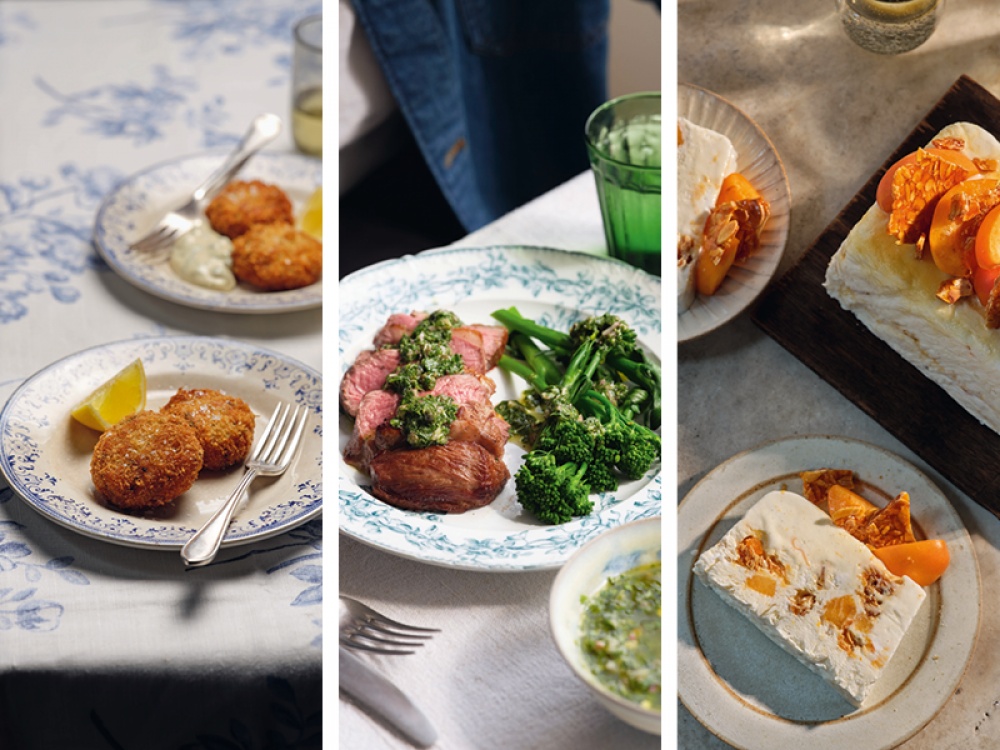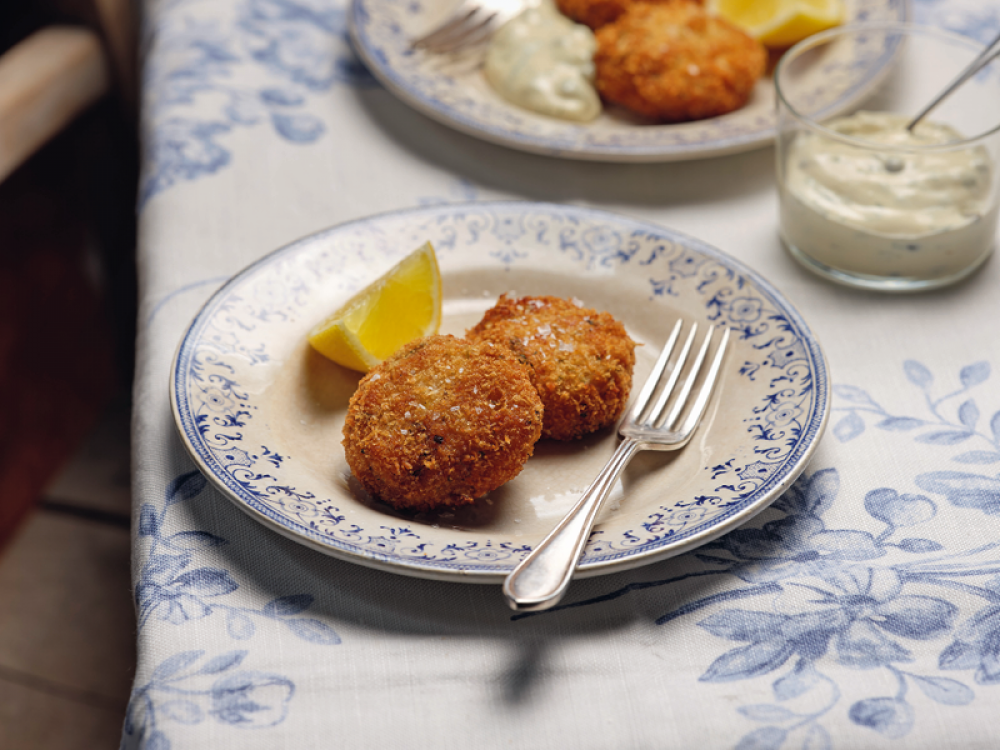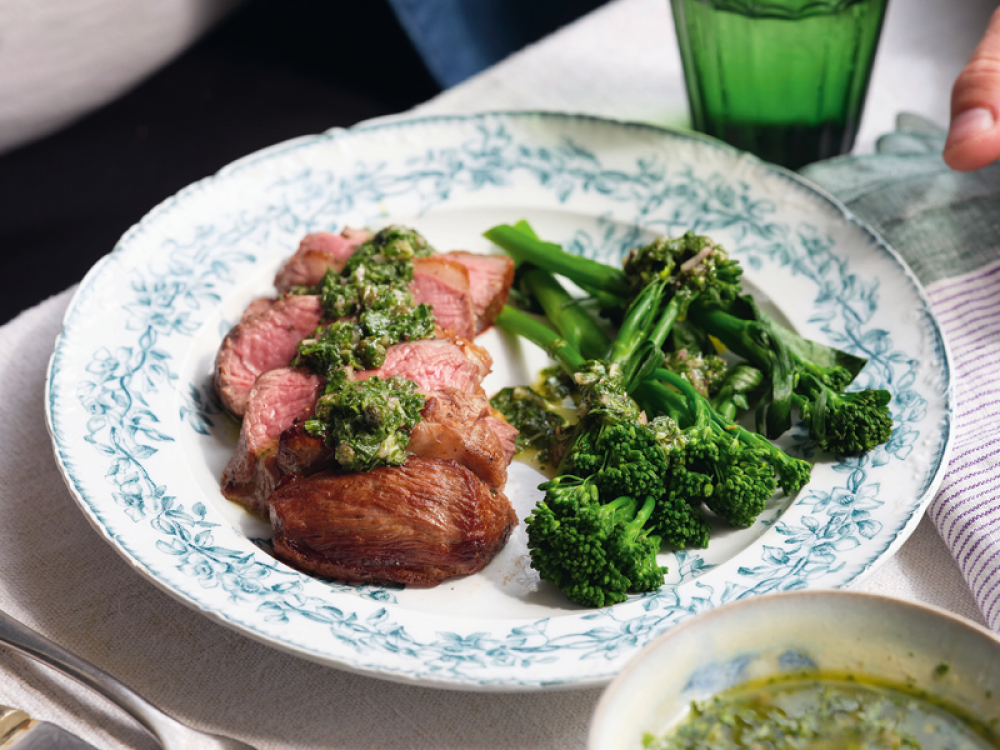
Tom Kerridge Shares Three Recipes from His New Book

Tom Kerridge goes old-school with his new book, Tom Kerridge Cooks Britain, that focuses on making the most of classic, seasonal British produce, including some from Yorkshire

Crab Cakes
‘We get succulent fresh crab from Cornwall and Orkney, but store-bought picked crab meat is a convenient way to enjoy this tasty shellfish,’ Tom says. ‘I add smoked paprika to these easy crab cakes, which lends a distinctive flavour not often used with seafood. The accompanying mayo – flavoured with fragrant dill, sharp lemon and salty capers – is a lovely foil.’
- 400g cod fillet, skin removed and pin-boned
- 1 large free-range egg white
- 1 tsp Dijon mustard
- Finely grated zest of 1 lemon
- ¼ tsp white pepper
- ½ tsp smoked paprika
- 200g white crab meat
- 1 tbsp finely chopped chives
- 1 tbsp roughly chopped dill
- 50g panko breadcrumbs
- Vegetable oil, to fry
- Salt and freshly ground pepper
Cut the cod into large chunks and place in a small food processor. Add the egg white, mustard, lemon zest, white pepper and smoked paprika and blend until smooth. Transfer the fish mixture to a bowl. Add the crab meat and chopped herbs with a good pinch of salt and fold through until the mixture is well combined.
Tip the panko breadcrumbs into a shallow bowl. Wet your hands with a little water (to avoid sticking), then divide the fish mixture into 12 even-sized pieces and shape into patties. Place each patty in the breadcrumbs and turn to coat well on both sides. Place these crab cakes on a tray in the fridge for 20 minutes to firm up.
Meanwhile, for the caper mayonnaise, put all the ingredients into a small bowl and mix well, seasoning with a little salt and pepper.
Heat about a one-centimetre depth of oil in a large, non-stick frying pan over a medium-high heat. When it is hot, carefully add the crab cakes and cook for two to three minutes on each side or until golden brown and cooked through. Remove from the pan and drain on a tray lined with kitchen paper.
Season the crab cakes with a little salt and serve them on individual plates with a dollop of caper mayonnaise and a lemon wedge.

Lamb Rump with Rocket Salsa Verde
‘Lamb chops are most people’s go-to for the barbecue, but I love the flavour of lamb rump. It’s an excellent cut that should be enjoyed heavily browned on the outside and pink in the centre,’ Tom explains. ‘The accompanying salsa verde is boldly flavoured and includes rocket for some peppery notes.’
- 4 boneless lamb rumps (300g each)
- 3 sprigs of rosemary, leaves picked and finely chopped
- Salt and freshly ground pepper
- For the rocket salsa verde
- 2 handfuls of rocket leaves (50g)
- A handful of basil leaves
- A handful of flat-leaf parsley leaves
- 1 small garlic clove, finely grated
- 120ml extra virgin olive oil
- 2 tsp Dijon mustard
- 3 tbsp baby capers
- 1 banana shallot, finely chopped
- 2 tbsp sherry vinegar
Preheat the oven to 200C/180C (Fan/Gas 6).
Trim any excess fat from the lamb rumps, leaving a very thin layer of fat on one side. Score the fat with a sharp knife and sprinkle both sides of the rumps with the rosemary and some salt and pepper.
Place a large non-stick frying pan over a medium heat and place the lamb rumps in the pan, fat side down. Let the fat render slowly from the lamb and cook for four to five minutes until the fat is crispy. Flip the lamb rumps over and cook for another three to four minutes.
Lift the lamb rumps out of the pan and lay them on an oven tray. Place in the oven for six to eight minutes, depending on their thickness, to finish cooking.
Meanwhile, make the rocket salsa verde. Put the rocket, basil, parsley and garlic into a food processor. Pour in the extra virgin olive oil and blend until smooth. Add the mustard, capers, shallot, sherry vinegar and a good pinch each of salt and pepper. Blend again, very briefly, then transfer the salsa verde to a bowl.
When the lamb is ready, remove from the oven and set aside to rest in a warm place for a few minutes. Carve the lamb and serve with the rocket salsa verde, and tender-stem broccoli or some chargrilled courgettes and peppers on the side.

Yoghurt and Apricot Parfait with Almond Praline
‘I use both natural and Greek yoghurts to achieve the ideal consistency in this parfait. It will serve a small crowd, but you can easily slice off fewer portions when you turn it out and return the rest of the parfait to the freezer for another time,’ Tom says. ‘Remember that single apiary, regional honey is superior to blended honey.’
- For the almond praline
- 100g flaked almonds
- 200g caster sugar
- For the parfait
- 8 apricots, stoned and roughly chopped
- Juice of 1 lemon
- 100ml blossom honey
- 300ml natural yoghurt
- 300ml Greek yoghurt
- 1 vanilla pod, split lengthways and seeds scraped out
- 3 large free-range egg whites
- 250g caster sugar
- To finish
- 4 ripe apricots, stoned and cut into wedges
Preheat the oven to 200C/180C (Fan/Gas 6). Wet the inside of a one kilogram (or two pound) loaf tin with a little water, then line with two layers of cling film, leaving some overhanging the edges.
For the praline, scatter the almonds on a small baking tray and place in the oven for eight to 10 minutes until lightly toasted. Meanwhile, line a heatproof tray with baking paper.
Tip the sugar into a small saucepan and place over a high heat. Swirl the pan as the sugar melts and forms a caramel. When the caramel is a deep golden brown colour, add the toasted almonds and stir quickly to coat. Spoon onto the lined tray, flatten with a rubber spatula and leave to cool completely. Once cooled, break off half of the praline, chop it finely and set aside. Save the rest for the decoration.
For the parfait, put the apricots into a small saucepan with the lemon juice and honey. Bring to a gentle simmer over a medium heat and cook for two minutes to soften the fruit, then remove from the heat. Leave this apricot compote to cool.
Place both yoghurts and the vanilla seeds into a large bowl and whisk together until smooth. Add half of the apricot compote to the bowl and mix well.
Put the egg whites into the clean, dry bowl of a stand mixer fitted with the whisk attachment. Tip the sugar into a small saucepan, add 50ml water and place over a medium-high heat to dissolve the sugar, then bring to the boil.
When the sugar syrup starts to boil, start whisking the egg whites on high speed. Once the syrup registers 117C on a sugar thermometer (the ‘soft ball’ stage), pour it onto the egg whites in a thin, steady stream, continuing to whisk.
When the sugar syrup is all added, turn the mixer speed to medium and whisk the meringue for a further five to 10 minutes or until the bowl is cooled down.
Add two large spoonfuls of the meringue to the apricot yoghurt mix and whisk to combine. Remove the bowl from the stand mixer. Add half of the remaining meringue and gently fold through the yoghurt, with a spatula. Repeat to incorporate the rest, folding it through until just combined. Finally, fold through the chopped praline.
Spoon half of the parfait mixture into the prepared tin. Dollop half of the remaining apricot compote over the parfait and swirl into the mixture. Spoon the remaining parfait mixture into the tin, dollop on the remaining apricot compote and swirl through.
Fold the excess cling film over the parfait and place in the freezer for at least three hours until firm, preferably overnight.
When you are ready to serve, turn the parfait out onto a board or plate and remove the cling film. Top with the apricot wedges and reserved praline, broken into shards. Using a warm knife, cut the parfait into thick slices and serve straight away.








